
Patsy Cline was an American singer from the state of Virginia. She is considered one of the most influential vocalists of the 20th century and was one of the first country music artists to cross over into pop music. Cline had several major hits during her eight-year recording career, including two number-one hits on the Billboard Hot Country and Western Sides chart.

"Crazy" is a song written by Willie Nelson and popularized by country singer Patsy Cline in 1961. Nelson wrote the song while living in Houston, working for Pappy Daily's label D Records. He was also a radio DJ and performed in clubs. Nelson then moved to Nashville, Tennessee, working as a writer for Pamper Music. Through Hank Cochran, the song reached Patsy Cline. After her original recording and release, Cline's version reached number two on Billboard's Hot Country Singles, also crossing to the pop chart as a top 10 single.
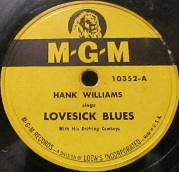
"Lovesick Blues" is a Tin Pan Alley song, composed by Cliff Friend, with lyrics by Irving Mills. It first appeared in the 1922 musical "Oh, Ernest", and was recorded that year by Elsie Clark and Jack Shea. Emmett Miller recorded it in 1925 and 1928, followed by country music singer Rex Griffin in 1939. The recordings by Griffin and Miller inspired Hank Williams to perform the song during his first appearances on the Louisiana Hayride radio show in 1948. Receiving an enthusiastic reception from the audience, Williams decided to record his own version despite initial push back from his producer Fred Rose and his band.

"Walkin' After Midnight" is a song written by Alan Block and Don Hecht and recorded by American country music artist Patsy Cline. The song was originally given to pop singer Kay Starr; however, her label rejected it. The song was left unused until Hecht rediscovered it when writing for Four Star Records. Originally Cline was not fond of "Walkin' After Midnight", but after making a compromise with her label she recorded it. However, the first released recording was by Lynn Howard with The Accents, released in August 1956.
"Have You Ever Been Lonely? " is a popular song with music by Peter De Rose and lyrics by Billy Hill, published in 1932. It has been recorded by many singers, becoming a standard.
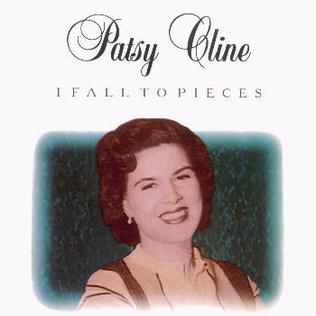
"I Fall to Pieces" is a song written by Hank Cochran and Harlan Howard that was originally recorded by Patsy Cline. Released as a single in 1961 via Decca Records, it topped the country charts, crossed over onto the pop charts and became among Cline's biggest hits. Cline was initially reluctant to record "I Fall to Pieces" and believed its production lacked enough country instrumentation for her liking. Eventually, Cline recorded the song upon the encouragement of her producer.

Honky Tonk Angels is a collaborative studio album by Dolly Parton, Loretta Lynn and Tammy Wynette. It was released on November 2, 1993, by Columbia Records. The album was certified Gold by the RIAA on January 5, 1994, for sales of 500,000 copies.
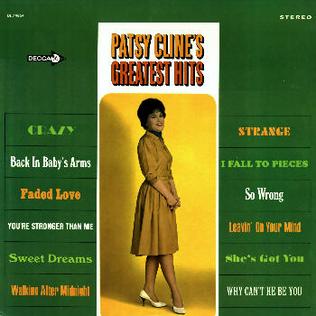
Patsy Cline's Greatest Hits is a compilation consisting of American country pop music singer, Patsy Cline's greatest hits. The album consists of Cline's biggest hits between 1957 and 1963. It is one of the biggest-selling albums in the United States by any female country music artist.

The discography of American music artist Patsy Cline consists of three studio albums, 24 singles, six extended plays, one compilation album, six other charted songs and one album appearance. Cline's discography contains material released during her lifetime. Her first recordings took place under the direction of Four Star Records. Cline's first single, "A Church, a Courtroom, Then Goodbye," was released in July 1955. Four Star issued 17 singles during Cline's four years recording with them. However, only "Walkin' After Midnight" (1957) became a major hit, reaching number 2 on the Billboard country songs chart and number 12 on the Billboard pop music chart.
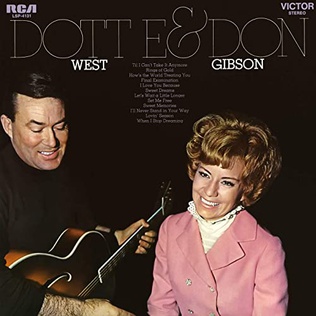
Dottie and Don is a studio album by American country music artists Don Gibson and Dottie West. It was released in March 1969 on RCA Victor Records and was produced by Chet Atkins and Danny Davis. The album was a collection of duet recordings between Gibson and West. It was both artists first album of duets to be recorded. Among the songs from the project, "Rings of Gold" became a major hit in 1969.
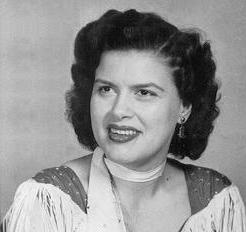
The posthumous discography of American singer Patsy Cline consists of recordings released after March 5, 1963. Since her death, Cline's record label and other labels have released numerous studio albums, compilation albums and singles. Decca Records planned to release Cline's fourth studio album at the time of her death. Instead, a compilation was released in June 1963 titled The Patsy Cline Story. The album reached number 9 on the Billboard country albums list and number 74 on the pop albums chart. Two singles posthumously released in 1963 became top 10 hits on the Billboard country songs chart: "Sweet Dreams " and "Faded Love". Following the release of two posthumous studio albums, Decca issued Patsy Cline's Greatest Hits in 1967. It was the highest-selling female country album for 28 years until Shania Twain surpassed her record in 1995. Greatest Hits was reissued multiple times and eventually was certified diamond in sales in the United States.
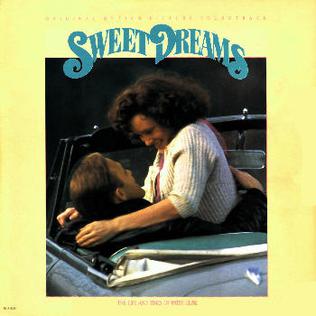
Sweet Dreams is the 1985 soundtrack album to the movie of the same name, starring Jessica Lange and Ed Harris about the life of country music star, Patsy Cline. The soundtrack is composed entirely of songs previously recorded and released by Patsy Cline.
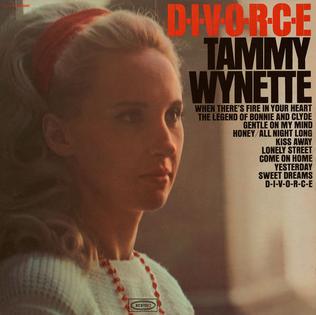
D-I-V-O-R-C-E is a studio album by American country artist Tammy Wynette. It was released in July 1968 via Epic Records and contained 11 tracks. Several recordings were cover tunes, including songs by Merle Haggard and The Beatles. Several new selections were also part of the collection, including the title track. Released as a single, the title track became Wynette's fourth number one song on the North American country charts in 1968. The album itself would also top the American country LP's chart in 1968. D-I-V-O-R-C-E received positive reviews from critics following its release.

"(I'd Be) A Legend in My Time" is a song written and recorded by Don Gibson in 1960. It appeared as the B-side of his hit "Far Far Away", from the album Sweet Dreams. Gibson re-recorded the song on the 1972 album Country Green.
"The Tip of My Fingers", also titled "The Tips of My Fingers", is a song written and originally recorded by American country music singer Bill Anderson. First included on his 1962 album Bill Anderson Sings Country Heart Songs, the song was a Top Ten country single for him in 1960.

"Sweet Music Man" is a song written and recorded by American musician Kenny Rogers. It appears on his 1977 album Daytime Friends, from which it was released as the final single.
"Making Believe" is a country music song written by Jimmy Work. Kitty Wells recorded a chart-topping version in 1955. The song is on many lists of all-time greatest country music songs and has been covered by scores of artists over the past fifty years, including Thorleifs, Bob Dylan, Johnny Cash, Don Gibson, Roy Acuff, Lefty Frizzell, Wanda Jackson, Connie Francis, Ray Charles, Anita Carter, Dolly Parton, Emmylou Harris, Merle Haggard, The Kendalls, Ernest Tubb, Skeeter Davis, The Haden Triplets, Social Distortion and Volbeat. The song is occasionally called "Makin' Believe".
"Lonely Street" is a 1956 song written by Carl Belew, Kenny Sowder, and W.S. Stevenson, originally performed by Belew, and later by Dave Rich.
"Why Can't He Be You"' is a song written by Hank Cochran that was originally recorded by American country artist Patsy Cline. The song became a minor chart hit was later included on Cline's Greatest Hits album. It has since been notably covered by Loretta Lynn and Norah Jones.
"Stop the World (and Let Me Off)" is a song written and originally performed by Carl Belew. It was released as a single first by Belew in January 1958. It was later followed by competing versions by Patsy Cline and Johnnie & Jack. The latter duo's version became the first successful version of the song to be a hit. It was later covered a decade later by Waylon Jennings and then again by Susan Raye in 1974.














